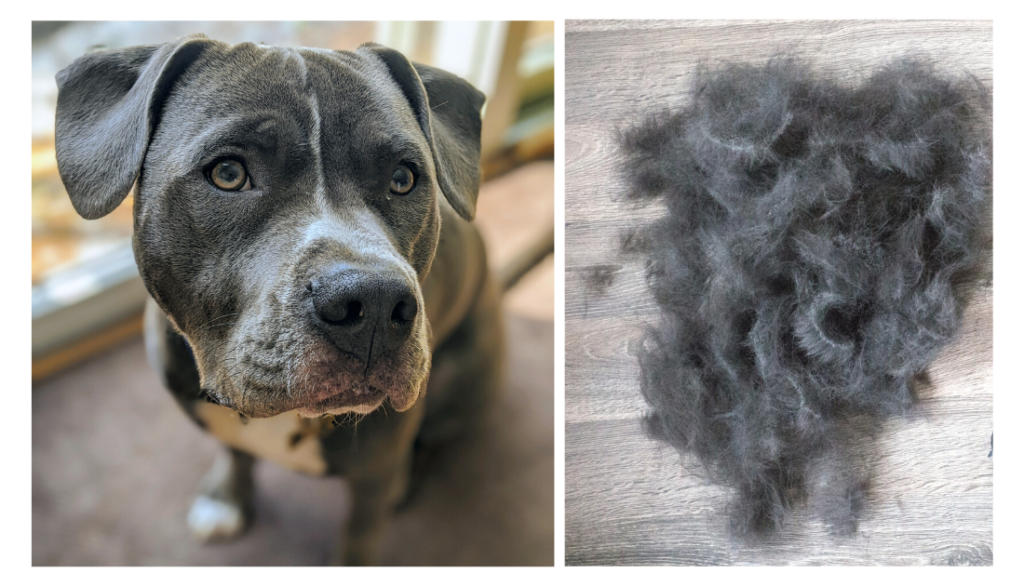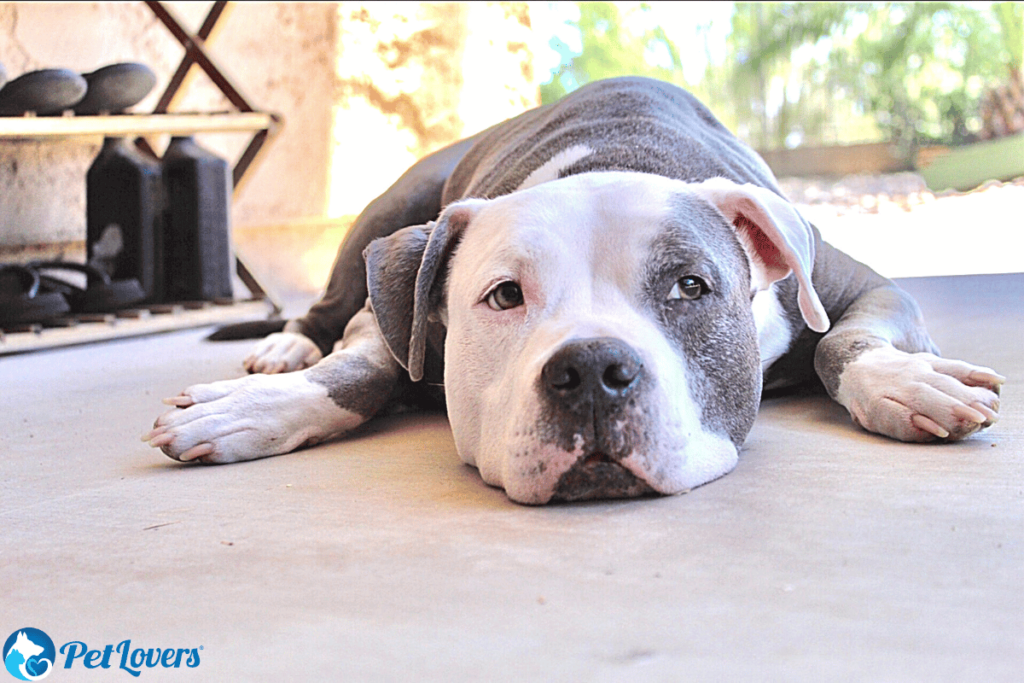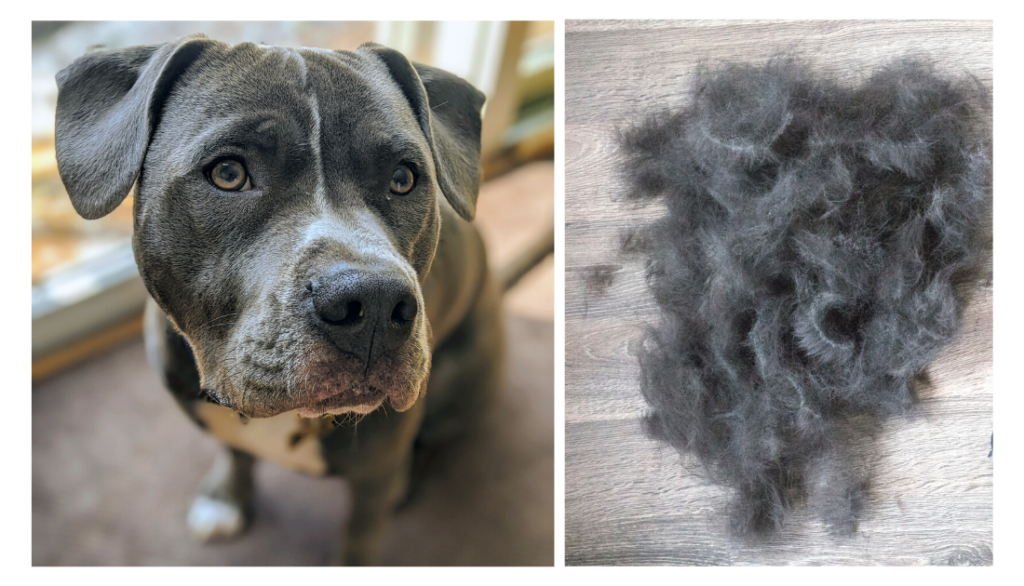Have you ever wondered why my Pitbull sheds so much? Well, the truth is that Pitbulls are actually heavy shedders. Despite their short hair, they have a dense coat that constantly sheds. Their shedding can be attributed to various factors such as weather changes, hormones, and overall health. So, if you find yourself constantly dealing with dog hair around your home, you’re not alone!
Pitbulls are known for their shedding tendencies, but there are ways to manage it. Regular brushing is essential to reduce shedding and keep their coat healthy. Additionally, a nutritious diet and proper grooming practices can help minimize excessive shedding. It’s important to remember that shedding is a natural process for dogs and cannot be completely eliminated. However, with proper care and attention, you can keep your Pitbull’s shedding under control and maintain a clean and fur-free living space. So, don’t despair, there are solutions to keep your Pitbull’s shedding in check!

Does My Pitbull Shed? Understanding Your Pitbull’s Shedding Habits
Are you a proud pitbull owner wondering about their shedding habits? In this comprehensive guide, we’ll dive deep into the question, “Does my pitbull shed?” Understanding your pitbull’s shedding patterns is essential for proper grooming and maintenance. From the causes of shedding to tips on managing it, we have you covered. Let’s explore everything you need to know about your pitbull’s shedding habits.
The Biology Behind Shedding in Pitbulls
Pitbulls, just like many other dog breeds, do shed. Shedding is a natural process where dogs lose their old or damaged hair to make way for new growth. It’s influenced by various factors, including breed characteristics, climate, and overall health. While pitbulls do shed, the intensity and frequency can vary from one dog to another. Understanding the biology behind shedding in pitbulls will help you manage it effectively.
Hormonal Influences on Shedding
One of the primary factors affecting shedding in pitbulls is hormonal changes. Hormones play a vital role in regulating the growth and loss of hair. When a pitbull reaches maturity or experiences hormonal fluctuations, shedding can increase. For example, female pitbulls may shed more during their heat cycles or after giving birth. Male pitbulls can also experience shedding during breeding season due to hormonal changes. Regular grooming and proper nutrition can help minimize shedding caused by hormonal influences.
Additionally, certain health conditions, such as allergies or hormonal imbalances, can lead to excessive shedding in pitbulls. If you notice a sudden increase in shedding or other unusual symptoms, it’s best to consult with a veterinarian to rule out any underlying health issues.
Climate and Seasonal Shedding
Pitbulls are adaptable dogs, but their coats can still be affected by climate and season changes. In colder months, they may develop a thicker coat to keep them warm, and as the temperature rises, they tend to shed the excess hair. This shedding process helps regulate their body temperature and allows for a lighter coat during warmer seasons. Regular brushing and grooming sessions can help manage seasonal shedding and keep your pitbull’s coat healthy.
Managing Shedding in Your Pitbull
While shedding is a natural process for pitbulls, there are several strategies you can use to manage it effectively. Here are some tips to help you keep your pitbull’s shedding under control:
Regular Brushing
Regular brushing is essential to remove loose hair and prevent it from accumulating around your home. Choose a suitable brush for your pitbull’s coat type, such as a slicker brush or a rubber curry brush. Brush in the direction of hair growth, using gentle strokes to avoid causing any discomfort. Not only will this help minimize shedding, but it also promotes healthy skin and coat.
Proper Nutrition
A well-balanced diet plays a significant role in your pitbull’s overall health, including their coat condition and shedding patterns. Ensure they are getting a high-quality dog food formulated for their specific nutritional needs. Diets rich in Omega-3 fatty acids and other essential nutrients can promote a healthy coat and reduce excessive shedding.
Frequent Baths and Grooming
Regular bathing and grooming sessions are vital to maintain your pitbull’s coat cleanliness and health. Bathe them using dog-specific shampoos and conditioners that won’t strip their natural oils. Follow up with thorough drying to prevent skin irritations. Additionally, keep their nails trimmed, ears clean, and teeth brushed to ensure overall hygiene.
Common Myths About Pitbull Shedding
With pitbulls being a popular breed, various myths and misconceptions surround their shedding habits. It’s essential to distinguish fact from fiction to better understand your pitbull’s specific needs. Let’s debunk some common myths about pitbull shedding:
Myth: Pitbulls Don’t Shed at All
Contrary to popular belief, pitbulls do shed. All dogs shed to some extent, and pitbulls are no exception. While they may not shed as heavily as some other breeds, they still require regular grooming and maintenance.
Myth: Shaving Your Pitbull’s Coat Stops Shedding
Shaving your pitbull’s coat does not stop shedding. In fact, it can disrupt their natural shedding pattern and cause potential skin problems. Pitbulls have a double coat that helps regulate their body temperature. Shaving can interfere with this natural process and may not yield the desired results. Instead, focus on proper grooming, brushing, and nutrition to manage shedding effectively.
Myth: Hypoallergenic Pitbulls Do Not Shed
While hypoallergenic dog breeds produce fewer allergens, there’s no such thing as a completely hypoallergenic pitbull. Pitbulls produce allergens in their saliva and dander, triggering allergies in sensitive individuals. While some pitbulls may cause fewer allergic reactions due to lower shedding, it’s essential to consult with a breeder or spend time with the dog to gauge your individual sensitivity.
Conclusion
Now that you have a better understanding of whether or not your pitbull sheds, you can confidently manage their shedding habits. Remember that shedding is a normal process, influenced by factors such as hormones, climate, and overall health. Regular brushing, proper nutrition, and grooming are key to minimizing shedding and maintaining a healthy coat. By following these guidelines and debunking common myths, you can provide the best care for your beloved pitbull.
Key Takeaways: Does My Pitbull Shed?
- Your pitbull will shed, but the amount of shedding varies.
- Regular brushing can help reduce shedding in pitbulls.
- Pitbulls have a short coat that is easier to manage.
- Seasonal changes can trigger increased shedding.
- Proper nutrition and grooming can minimize excessive shedding.
Frequently Asked Questions
Pitbulls are known for their strong and muscular build, but what about their shedding? Here are answers to some common questions about pitbull shedding.
1. Why does my pitbull shed?
Pitbulls have a short and smooth coat, which means they shed regularly. Shedding is a natural process for dogs to get rid of old or damaged hair and make way for new growth. While some breeds shed more than others, every dog will shed to some extent. With pitbulls, you can expect a moderate amount of shedding all year round.
To keep your pitbull’s coat healthy and minimize shedding, regular grooming is essential. Brush your pitbull’s coat at least once a week to remove loose hair and prevent mats. A balanced diet rich in Omega-3 fatty acids can also help maintain a healthy coat and reduce excessive shedding.
2. How often should I groom my pitbull to manage shedding?
To manage shedding, it’s recommended to groom your pitbull at least once a week. Regular brushing helps remove loose hair and prevents it from ending up all over your furniture and clothes. Additionally, grooming sessions provide an opportunity to check for any skin issues, parasites, or abnormal lumps.
Besides brushing, other grooming tasks like bathing should be done as needed. Over-bathing can strip the natural oils from your pitbull’s coat and cause dryness. Always use a dog-specific shampoo that is mild and won’t irritate your pitbull’s skin. Regular grooming sessions not only help manage shedding but also keep your dog’s coat clean and healthy.
3. Are there any specific tools or brushes that work best for pitbull shedding?
When it comes to managing a pitbull’s shedding, the right tools can make a big difference. A rubber curry brush is a great option for removing loose hair and stimulating the skin. The rubber bristles help catch the hair effectively. Additionally, a slicker brush with fine bristles can help remove any remaining loose hair and prevent mats.
Some pitbull owners also find deshedding tools, such as an undercoat rake or a deshedding tool with a shedding blade, helpful for managing heavy shedding periods. However, always be gentle when using these tools and avoid applying too much pressure, as it can potentially harm your dog’s skin.
4. Can I do anything besides grooming to minimize my pitbull’s shedding?
In addition to regular grooming, there are a few other things you can do to minimize your pitbull’s shedding. Ensuring a proper diet is crucial, as nutrition plays a significant role in your dog’s coat health. Feed your pitbull a balanced diet with high-quality dog food that contains essential nutrients like Omega-3 fatty acids.
Regular exercise is also important. Physical activity stimulates blood flow and supports a healthy coat. Moreover, keeping your pitbull hydrated by providing fresh water throughout the day helps promote healthy skin and coat. Lastly, regular visits to the vet can help address any underlying health issues that might be contributing to excessive shedding.
5. Is there anything I should avoid doing when it comes to managing my pitbull’s shedding?
While grooming and regular maintenance are essential for managing a pitbull’s shedding, there are a few things to avoid. Firstly, never shave your pitbull’s coat, as it can disrupt their natural body temperature regulation and cause sunburn. The short coat of a pitbull is designed to protect them from overheating and extreme weather conditions.
Avoid using human hair products on your pitbull, as they are not formulated for dogs and may irritate their skin or cause allergies. Lastly, refrain from excessive bathing or using harsh shampoos, as these can strip the natural oils from your pitbull’s coat and lead to dryness and more shedding.

